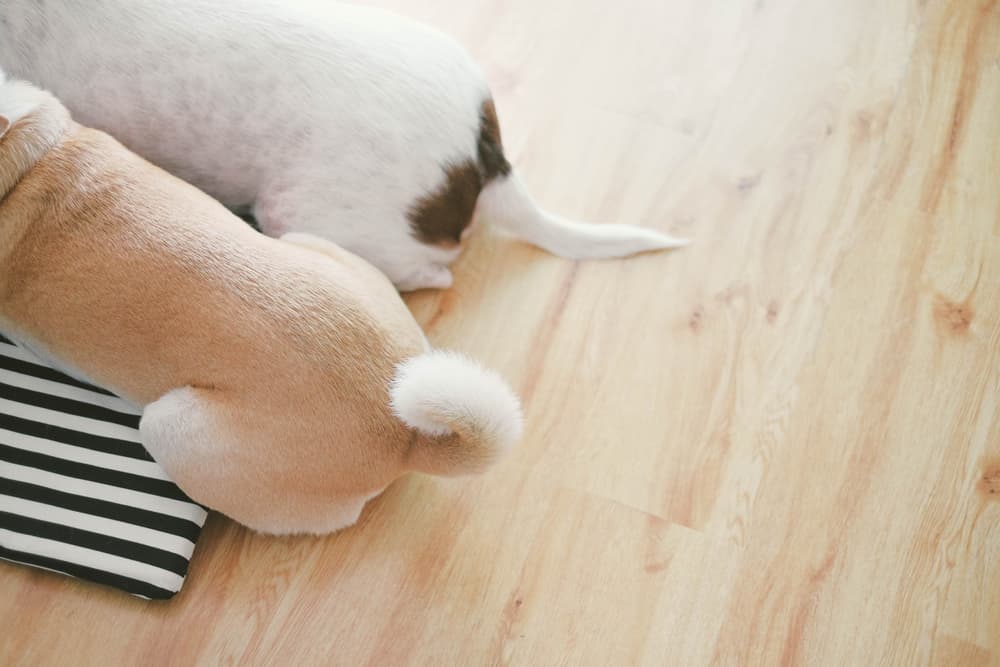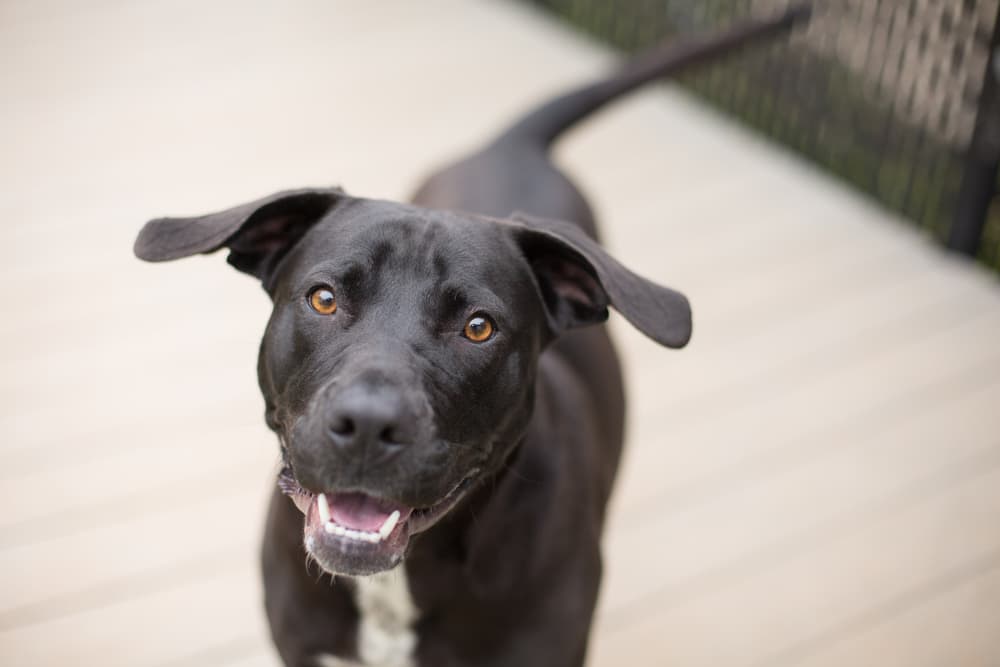Dog Tail Facts: Info on Wagging, Chewing, and More

There’s nothing better than the sight of your dog wagging their tail after coming home after a long day. You can’t help but smile when you are greeted with such happiness and excitement, right?
Dogs are visual communicators when it comes to broad cues, and tail wagging is one of the ways they can “speak” to others. Their vision is movement oriented, so the tail can play a big role in how they communicate with other pets and their owners. Some dog tails have even adapted over time to be fluffier or feature brighter colors to enhance tail wagging communication.
Learning to brush up on dog tail facts will help you better understand your dog’s body language and ultimately help you communicate better with your canine companion. Let’s cover everything you need to know about your pup’s tail.
Dog Tail Anatomy: Understanding the Basics

Besides conveying happiness or other visual cues, dogs use their tails for balancing purposes and other athletic movements. The tail is essentially a continuation of the spine, with many of the same features.
What is a Dog’s Tail Made Of?
Dog tails are made of vertebrae, muscles, cartilage, and nerves. The number of caudal vertebrae in a dog’s tail is highly variable.
A dog’s tail also consists of muscles that attach to the vertebrae that help to control the conscious movement of the tail. It is also innervated by nerves to help control the movement of the tail, ranging from 4 to 7 paired nerves.
Do Dogs Have Bones in Their Tails?

Yes, dogs do have bones in their tails. The vertebrae mentioned above is what we refer to as the bones in a dog’s tail. Most dogs have 20 caudal vertebrae, but each dog breed can have different variations.
Between the vertebral bodies is cartilage, a flexible connective tissue, which helps cushion moving surfaces of joints, such as between the tail bones. This helps with the fluid movement when a dog wags their tail or curls it between their legs when they are scared.
Why Do Dogs Wag Their Tails?

Dogs generally wag their tails to communicate with other dogs on how they’re feeling as they approach one another. The wag of a dog’s tail may signal that they are:
- Happy
- Aggressive or agitated
- Curious
- Submissive or scared
While a dog’s tail can provide clues about whether they are happy or not to see you, it can be very difficult to know what a dog is thinking by looking at their tail alone. It is important to consider the dog’s overall body posture when evaluating their emotional state. Generally, a dog is considered relaxed and happy if they approach you with a relaxed, wagging tail that moves loosely from side to side or around like a helicopter. It’s important to interpret what a dog’s tail wag means in context. If you are unsure, let the dog decide to come to you instead of approaching them.

Aggression can be represented by dogs raising their tails to an upward or a curved position. The high tail position conveys “bigness” and dominance, and when the tail is raised, the scent markers (anal glands) can be released easier into the area.
Curious dogs tend to hold their tails in a neutral position or horizontal position straight out from their body.
Submissive or scared dogs lower their tail from a neutral position. They want to be perceived as unthreatening, so they make themselves seem smaller. If the tail is tucked under, they are fearful, and this prevents any of their scent from escaping into the area so they can go relatively undetected.
Can Dogs Control Their Tails?

Dogs do have the ability to control their tail through muscle, but it can be somewhat involuntary like a laugh, smile, or frown in humans. We can control our mouths and voices, but sometimes it seems involuntary when a laugh escapes!
Nerves innervate the tail, and muscles attach to the caudal vertebrae to help with the conscious movement of the tail. This helps to convey what the dog is portraying to the outside world.
Dogs also control and use their tails as part of balancing or during agility exercises.
Why Do Dogs Chew Their Tails?

Dogs chew their tails for a variety of reasons ranging from fleas and allergies to pain and injuries. If a dog is chewing their tail, it could be caused by one of the following conditions:
- Fleas
- Hot spot
- Anal gland irritation
- Neurologic issue
- Pain
Fleas tend to congregate around the tail base, and usually the telltale sign is frantically turning around and biting that area. The skin could appear red or inflamed, and you may see flea dirt or even fleas when parting the hair around the tail base.
Hot spots are another reason that your dog could be itching their tail base. Some dogs have folds (Bulldogs, French Bulldogs, Pugs, Shar Peis) around their tail base that can trap moisture and create a yeast and bacteria haven that turns into a hot spot. The dogs will do anything to itch and scratch that area.

If your dog has full anal glands, they may scoot on their butts on the ground or carpet, since full anal glands creates an itchy and uncomfortable feeling. Some will even try to lick and scratch that area but won’t be able to reach the rectum, so they get their tail instead! If they scoot a lot on their butt, they can create irritation underneath their tails, which can turn into a hot spot.
Nerve damage or degeneration can cause pain, tingling, or an uncomfortable feeling leading into the tail. Dogs will lick to soothe or bite if they feel tingling or uncomfortableness.
If trauma or pain is the cause, many dogs will lick to soothe the pain. Dogs can get their tails caught in doors, stepped on, hurt in fights, or bit or stung by insects (like bees), all which can cause tail pain and inflammation.
Dog Tail Language: Cues and Communication Guidelines

A dog’s tail plays a key role in body language communication. Here are some tail signs to look for that will help you understand how your dog is feeling.
Free, Loose Tail Wagging
When a dog is freely wagging their tail, they are relaxed and happy. They might be excited about greeting someone, ready to go for a walk, or realizing they’ve arrived at their favorite spot. This type of tail wag is loose and easy. It looks effortless and signals that your dog is zen and content about whatever is happening.
Tucked Tail

If a dog’s tail is tucked, they are nervous and scared. They are trying to remain small and undetected by any threat. If they have done something naughty, and know they are about to get in trouble, many dogs will sense this and tuck their tails in order to convey they are not a threat, and will hopefully go unnoticed.
Tail Standing Straight Up
If the tail is standing up straight or seemingly the dog is trying to look bigger, this could be used as a threat. They are showing they are ready to defend or fight, and want to be an alpha in the situation by exposing their scent glands when lifting their tail.
Dog Tail Speed: What to Watch For

The speed in which dogs wag their tails can also communicate a lot. If they are wagging their tail very fast with a little bit of hip wiggling, it can indicate the increased level of excitement when greeting their pet parent or favorite friend.
If a dog is a little more tentative when approaching someone new, but they want to appear friendly, they may wag their tail a little more slowly. They want to convey friendliness, but still have their guard up a bit.









